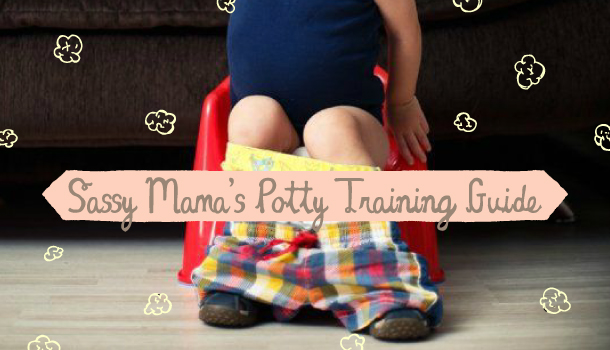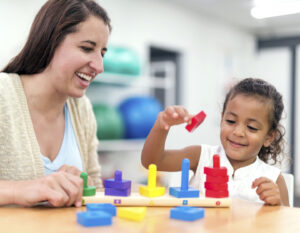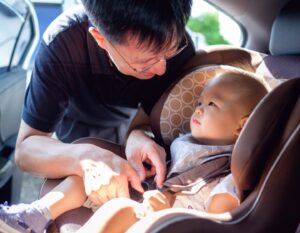

Ready to ditch the nappies? Potty training can lead to greater independence for your child, allow them to meet basic requirements for school entry, give your family more freedom and less travel hassle, and of course, is more environmentally friendly! It is important to make sure your family is prepared for the transition from nappies to the potty and the information below can help you decide the best approach to take:
Is Your Child Ready?
- Your child should be at least 2 years old.
- Your child should have periods of the day (a couple hours) when he/she is dry.
- Your little one should be familiar with toileting language such as ‘potty’, ‘ toilet’, ‘underpants’, etc. The words you choose should be specific to your family, used consistently, and words you are comfortable saying in public.
- He/she should be capable of pulling up and down their pants independently or with minimal assistance (depending on the clothing attire).
- Your child is able to follow simple one-step instructions without difficulty, such as “Come here” and “Sit down”. If you have trouble getting your little one to listen on a regular basis, see your physician or a pediatric psychologist first to address behaviour management issues.
- Your child should show awareness of the need to use the toilet after he/she has soiled their nappy. For instance, a child may point to their nappy, ask to be changed or take your hand and lead you to the changing area.
- Your little one should understand the concept of what the toilet is used for. You can teach this by modeling or reading books about going to the toilet. If your child seems to have difficulty with any of these skills, talk to your pediatrician before beginning toilet training.
Is Your Family Ready?
- Make sure there are no stressful events taking place or coming up in the near future (e.g. moving, change in caretakers).
- Ensure you are ready to commit to this change and will have the time to be consistent and patient with your child.
- Make sure everyone in the home (including domestic helpers, nannies and grandparents) fully understand the plan and what to do when accidents happen.
- Purchase a potty-chair, stool or toilet seat adapter so your child’s feet touch the floor for support.
- Have a reward system developed. This can include a variety of preferred toys, stickers, snacks, games and special one-on-one time with a parent. Star charts are a great way to track goals and help remind parents to reward progress.
- Ditch the nappies but be prepared for accidents! Remember, accidents are normal and part of the training process.
- It is important to toilet train children in big kid underwear/training pants. Having your child pick out their own new underpants can make this process more fun and something to look forward to. Which method to use? Slow and steady: for some children, modelling, practice and praise can be enough.

Toilet Training 1, 2, 3
1. Take your child to the bathroom with you so they can learn from an expert how it is done.
2. Have your child practice sitting on the potty when you first purchase the chair. This can be done as “pretend practice” with their clothes on. Praise your child and show excitement when they sit on the potty. Now, it’s time to ditch the nappies!
3. Next, have your child sit regularly on the potty throughout the day so there are lots of chances for them to use it properly. Ask your child routinely if he/she needs to “go”. Remember to have your child sit, even if they say they don’t need to “go”. Sometimes children don’t recognise the urge until they are relaxed and not distracted by other things (e.g., playing, watching T.V.).
4. Make sure to give your child lots of praise each time they urinate or have a BM in the potty. You can use larger rewards from the reward menu as well.
Intensive Method
If regular toilet training per above is not successful, you can try a more intensive method such as the weekend fast track. Some children may require intensive toilet training for a number of reasons (e.g. family convenience, urgency due to school entrance deadlines, etc.). This type of training typically takes place over a weekend when a family can devote their time and energy to the procedure at home. For this process, it is helpful to keep kids “pants free” (underpants and a shirt only) at home for the day.
1. The first step is to ditch the nappies!
2. The next step is to increase fluids by giving your child at least one cup of liquid every hour. Consider varying the beverage so your child will continue to drink.
3. Next, start off reminding your child to use the potty every 15 minutes and taking them for a sit. This will help your child learn to self-initiate and recognise when they need to go. As your child learns to request the potty and urinate with more independence, you can spread out the time between sits/reminders (15, 30, 45, 60 minutes).
4. Complete pant checks (dry pants vs. wet pants) at the same time you give the reminder. If your child is dry, praise him/her for this accomplishment (“Great job, you still have dry pants!”) but if they are wet, follow through with the toilet sit and then clean up the accident.
5. Don’t have lengthy discussions about the accident, just move on. Instead, focus giving your attention for the positive accomplishments.
6. Each time they sit on the toilet, praise your child for listening. Remember, this is not necessarily fun for them either! Provide a small treat or time with a preferred special toy each time he/she urinates or has a BM in the potty. When your child self-initiates and uses the toilet, make a big deal out of it. This is cause for celebration! Have something special planned for when this happens (special play time with a parent, new toy, colouring book or stickers).
7. Complete this process over the entire weekend. By the end of the weekend (Sunday afternoon) you should be providing reminders and having toilet sits every 1-2 hours depending on when your child is consuming more fluids.
Urine alarm: This device is attached to your child’s underpants and buzzes when moist. Typically the sound/vibration of the buzzer will cause the child to immediately stop urinating temporarily so you can get him/her to the bathroom. This allows your child to have more successful sits on the potty and for you to know if an accident occurs. The device can be used as part of the toilet training process.
General Tips
- Remember how much your child values your attention! When your child urinates in the potty, congratulate them by providing lots of praise (Attaboys, high fives, hugs!). Give them something special immediately after they use the potty successfully rather than later in the day.
- Expect accidents. If your child has an accident, do not scold, shame or punish him/her. Simply say, “No wet pants” in a neutral tone, take them to the potty, and have them sit for about one minute. If they finish urinating in the toilet, praise them! If they are unable to go, it is OK. Clean them up and go back to your daily routine. There will be plenty of chances to try again.
- Complete pant checks throughout the day. If your child is dry praise them for learning to control their bladder/bowels by telling them, “Nice job, you have dry pants!”
- Take them to the toilet frequently throughout the day so they have more opportunities to go in the potty and fewer chances of having accidents.
- Stay calm and be patient. Learning any new skill takes time, practice and positive feedback.
- Keep the nappies on at night. Children take longer to be consistently dry at night vs during the day. If you are not seeing progress, or your child experiences unusual or unexpected reactions, stop the training and contact a professional (physician, pediatric psychologist) right away. Most often the complication can be easily addressed and your family can be back on track in no time!
![]()
![]()
For additional resources on toilet training, check out “Toilet Training in Less than a Day”, available online at Amazon here.
Featured image from Pinterest, Image #2 from Shutterstock
 View All
View All











 View All
View All





 View All
View All


 View All
View All














